|
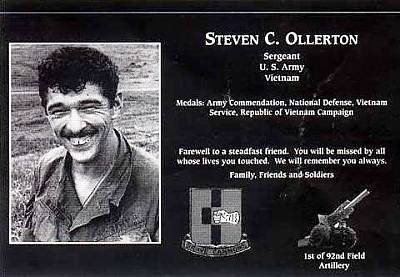 *NOTE:
Steve 'Ollie' Ollerton passed away on March 25, 2002. He was
a great assest to the 1/92nd FA both in RVN and at home. *NOTE:
Steve 'Ollie' Ollerton passed away on March 25, 2002. He was
a great assest to the 1/92nd FA both in RVN and at home.
A
frequent contributor, Steve was also instrumental in starting and maintaining
the web site for the 1/92nd FA Association, VN.
This is the Steve's Memorial Plaque on Mount Soledad in Southern California.
|
|
|
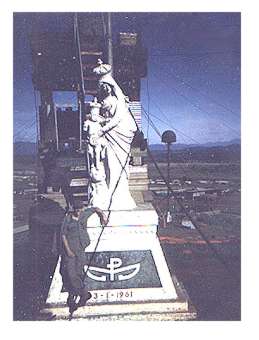
After
arriving at Bien Hoa, I flew North to Nha Trang, and then on to Pleiku
This took two days, and I found myself on guard duty in a tower on the
perimeter of Artillery Hill. I was a member of Charlie Battery 1/92nd
Artillery, a 155mm towed Howitzer unit. Artillery Hill was our base
camp, and on top of the hill stood a statue of the Virgin Mary that
honored the French soldiers killed in a massacre in the Mang Yang Pass
just to the East of Pleiku. Everyone at the hill had their picture taken
at the statue, and I was no exception. We are looking West here, and
directly behind the statue is a tower with a search light. I was told
that it could light up a hill twenty miles away, bright enough to cast
shadows. The few times I saw it working, I believed it.
|
|
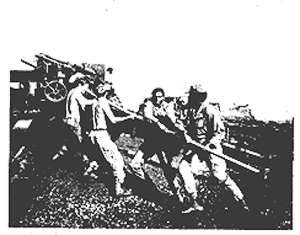
One
of the daily activities of a gun section is the cleaning of the gun
in the morning. Most of the time we would clean it right after breakfast.
It didn't matter if you had cleaned it at three in the morning (0300),
you still gave it a good going over in the daylight. One man, usually
a tall guy, would stand at the muzzle of the gun, and pour rifle bore
cleaner (RBC) down the tube, while everyone else pushed, and pulled
a bronze bristle brush through the barrel to get all the dirt, and burnt
powder out. After that two guys would wrap a rope around the barrel,
and pour RBC over the outside and in a sawing motion, working up and
down the barrel they would clean the outside to a high shine. The Asst.
Gunner would make sure the breech was clean, and operational, and the
Gunner would bore sight the scope to make sure it was aligned with the
barrel. The aiming stakes would be properly aligned, and the ammo, and
powder bunkers would be replenished.
|
|
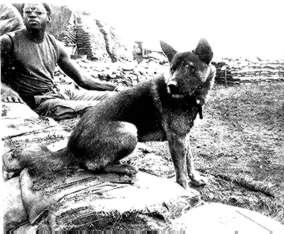 Every
gun in Charlie Battery sported a mascot. Gun six had a dog of the most
dubious parentage possible. Here is Kom Sa, the ugliest dog in the field
artillery! He went with us everywhere we travelled, and stood guard
with us every night. For rations, and a little attention, he gave us
100%. His alert ears, and nose, probably kept more than one sapper at
bay. Every
gun in Charlie Battery sported a mascot. Gun six had a dog of the most
dubious parentage possible. Here is Kom Sa, the ugliest dog in the field
artillery! He went with us everywhere we travelled, and stood guard
with us every night. For rations, and a little attention, he gave us
100%. His alert ears, and nose, probably kept more than one sapper at
bay.
Behind
Kom Sa is Tommy Gray. It was a rare thing to see Tommy sitting down.
He was a workaholic, and always on the go. When I became section chief
of the gun, it was my privelage to promote him to Sp4. It was something
that should have happened sooner, but isn't that always the case.
You
can see that the gun has torn up the top layer of sandbags along the
pit wall. About every other week another layer of bags would have to
be added to the wall. You could usually tell which direction we fired
the most by which part of the circle had the most torn up sandbags.
|
|
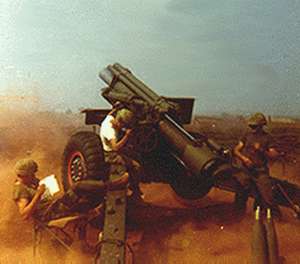 This
picture was taken out at Plei M'Rong, northwest of Pleiku. We took over
for A Battery who were getting ready for the invasion of Cambodia. We
really had a great time out there. In this picture we are firing a registration
mission, so Red, our section chief, is being real casual. Our gunner,
Gardner (in the white shirt), would be going home in two weeks. Mike,
the asst. gunner (far right), would be moved to another gun. I would
become asst. gunner, the job I liked most on the gun, and we would get
two new guys. Red would start teaching me to be gunner, and in two months
I would go from projo man to section chief. I would feel about as out
of place as I could feel, and the only saving grace would be the fact
that the rest of the gun section would know what they were doing. This
picture represents about the last week of being a care free gunbunny.
It is also about the best picture I ever took of the gun in action.
That was some of the finest, and reddest dirt I ever encountered there
at Plei M'Rong. This
picture was taken out at Plei M'Rong, northwest of Pleiku. We took over
for A Battery who were getting ready for the invasion of Cambodia. We
really had a great time out there. In this picture we are firing a registration
mission, so Red, our section chief, is being real casual. Our gunner,
Gardner (in the white shirt), would be going home in two weeks. Mike,
the asst. gunner (far right), would be moved to another gun. I would
become asst. gunner, the job I liked most on the gun, and we would get
two new guys. Red would start teaching me to be gunner, and in two months
I would go from projo man to section chief. I would feel about as out
of place as I could feel, and the only saving grace would be the fact
that the rest of the gun section would know what they were doing. This
picture represents about the last week of being a care free gunbunny.
It is also about the best picture I ever took of the gun in action.
That was some of the finest, and reddest dirt I ever encountered there
at Plei M'Rong.
|
|
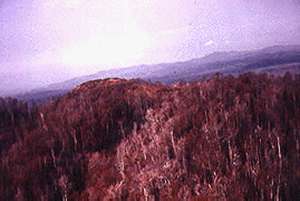 These
last two pictures were taken by Jay Livesay. Jay and I went through
the Army together, and he ended up in B Battery out at Ben Het. We went
home on the same Freedom Bird, and remain friends today. These
last two pictures were taken by Jay Livesay. Jay and I went through
the Army together, and he ended up in B Battery out at Ben Het. We went
home on the same Freedom Bird, and remain friends today.
This picture
is of Firebase 6. Four guns of B battery were there during my entire
tour. It covered a large area of the Dak To valley, and mountains to
the west. When we were at Dak To during the Siege of Dak Seang,, FB
6 fired support for us, and we returned the favor. They could also support
Ben Het, as could we. This series of interlocking firebases made it
hard for the enemy to cause trouble for any one firebase. You will notice
that it seems like Autumn around FB 6. That is the result of agent orange,
and other defoliantes spayed in the area. It was only later that we
learned of the bad effects these defoliantes had on humans.
|
|
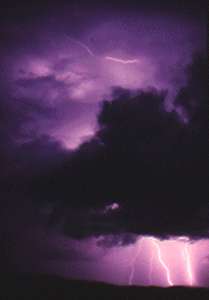
This is
the best picture I can find to represent the monsoon season. Jay took
this out at Ben Het, but I am sure that anyone that spent time in the
Highlands ran into storms like this. At Dak To we had all our claymor
mines set off by lightening. I thought we were getting hit, and wondered
how they knew where to aim in that downpour. One of my men was carrying
a shovel, and got nailed in the neck by lightening. It was bad enough
to knock him out face-first in the mud. He came to after a buddy and
I carried him over to HQ. As a boy raised up in southern California,
that was about as wild a weather as I have ever seen.
|
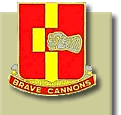

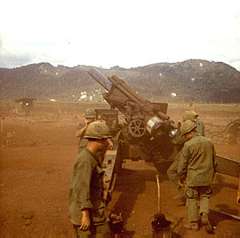
 *NOTE:
Steve 'Ollie' Ollerton passed away on March 25, 2002. He was
a great assest to the 1/92nd FA both in RVN and at home.
*NOTE:
Steve 'Ollie' Ollerton passed away on March 25, 2002. He was
a great assest to the 1/92nd FA both in RVN and at home. 

 Every
gun in Charlie Battery sported a mascot. Gun six had a dog of the most
dubious parentage possible. Here is Kom Sa, the ugliest dog in the field
artillery! He went with us everywhere we travelled, and stood guard
with us every night. For rations, and a little attention, he gave us
100%. His alert ears, and nose, probably kept more than one sapper at
bay.
Every
gun in Charlie Battery sported a mascot. Gun six had a dog of the most
dubious parentage possible. Here is Kom Sa, the ugliest dog in the field
artillery! He went with us everywhere we travelled, and stood guard
with us every night. For rations, and a little attention, he gave us
100%. His alert ears, and nose, probably kept more than one sapper at
bay.  This
picture was taken out at Plei M'Rong, northwest of Pleiku. We took over
for A Battery who were getting ready for the invasion of Cambodia. We
really had a great time out there. In this picture we are firing a registration
mission, so Red, our section chief, is being real casual. Our gunner,
Gardner (in the white shirt), would be going home in two weeks. Mike,
the asst. gunner (far right), would be moved to another gun. I would
become asst. gunner, the job I liked most on the gun, and we would get
two new guys. Red would start teaching me to be gunner, and in two months
I would go from projo man to section chief. I would feel about as out
of place as I could feel, and the only saving grace would be the fact
that the rest of the gun section would know what they were doing. This
picture represents about the last week of being a care free gunbunny.
It is also about the best picture I ever took of the gun in action.
That was some of the finest, and reddest dirt I ever encountered there
at Plei M'Rong.
This
picture was taken out at Plei M'Rong, northwest of Pleiku. We took over
for A Battery who were getting ready for the invasion of Cambodia. We
really had a great time out there. In this picture we are firing a registration
mission, so Red, our section chief, is being real casual. Our gunner,
Gardner (in the white shirt), would be going home in two weeks. Mike,
the asst. gunner (far right), would be moved to another gun. I would
become asst. gunner, the job I liked most on the gun, and we would get
two new guys. Red would start teaching me to be gunner, and in two months
I would go from projo man to section chief. I would feel about as out
of place as I could feel, and the only saving grace would be the fact
that the rest of the gun section would know what they were doing. This
picture represents about the last week of being a care free gunbunny.
It is also about the best picture I ever took of the gun in action.
That was some of the finest, and reddest dirt I ever encountered there
at Plei M'Rong. These
last two pictures were taken by Jay Livesay. Jay and I went through
the Army together, and he ended up in B Battery out at Ben Het. We went
home on the same Freedom Bird, and remain friends today.
These
last two pictures were taken by Jay Livesay. Jay and I went through
the Army together, and he ended up in B Battery out at Ben Het. We went
home on the same Freedom Bird, and remain friends today.